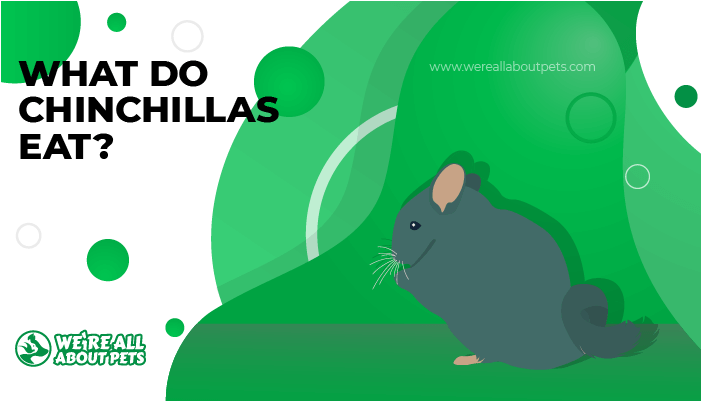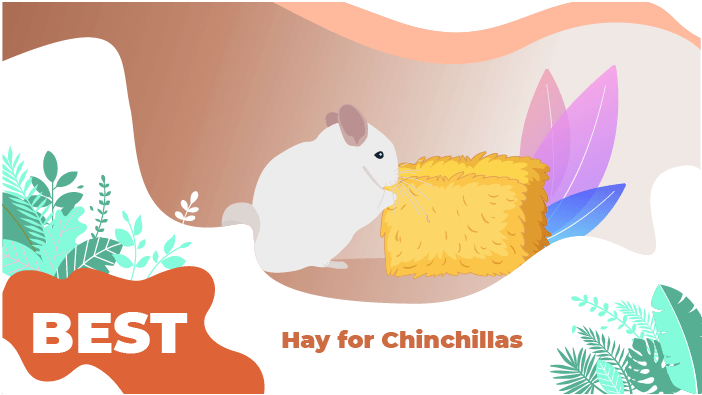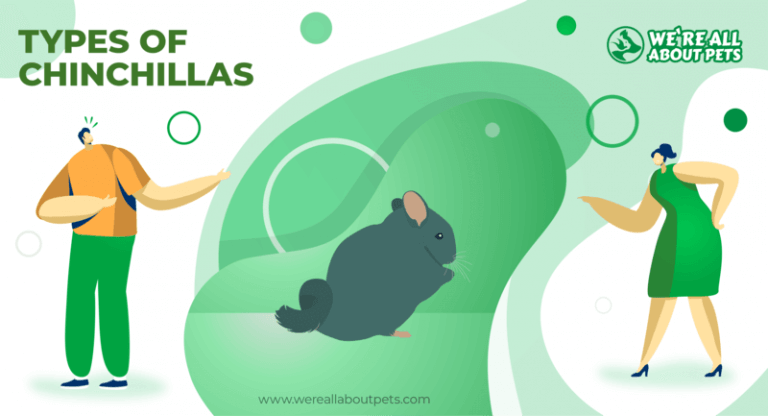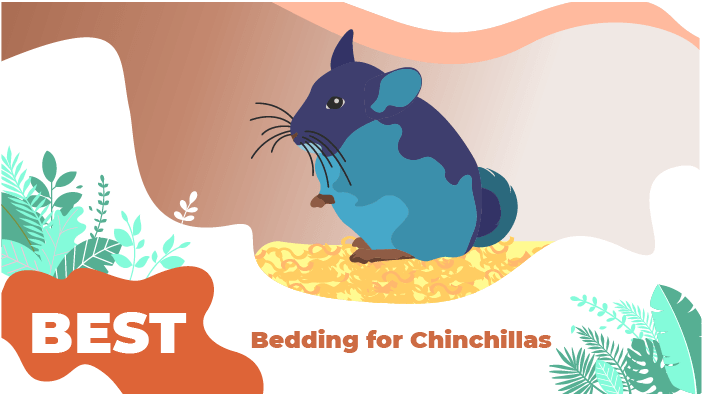What Do Chinchillas Eat?
This page contains affiliate links. We may earn money or products from the companies mentioned in this post through our independently chosen links, which earn us a commission. Learn More

When it comes to traditional pets, most people think of cats and dogs and sometimes small animals like guinea pigs or hamsters. The chinchilla is not the most common pet around, but it is a wonderful pet to consider.
These furry animals are very active and playful. When properly handled, they can even bond quite closely with their owners.
Though the chinchilla makes a wonderful pet, you need to be sure you’re up for the challenge.
Not only do these small animals have unique requirements for care, but they need a specific diet as well.
The chinchilla has a sensitive digestive tract so, unless you meet your pet’s strict dietary requirements, he may fail to thrive.
Fortunately, with commercial chinchilla foods commonly available at the pet store and through online retailers like Amazon, it’s easy to find the food your pet needs.
To help you choose the best diet that will meet your pet’s requirements and be gentle on your chinchilla’s digestive system, we’ve assembled a list of safe and unsafe foods. Read on to see our recommendations for what to feed pet chinchillas.
Quick Navigation
Safe and Unsafe Foods for Chinchillas

As a chinchilla owner, it’s your job to make sure your pet’s needs are being met and that you don’t accidentally give him food that might harm him.
The chinchilla has a very sensitive digestive tract, so he is very prone to gas and bloating.
The wrong foods can trigger these issues and could make your chinchilla very sick.
Here’s a list of dozens of foods that are and aren’t safe for your new pet:
Foods That Are Safe for Chinchillas:
- Commercial chinchilla pellets
- Timothy hay
- Alfalfa hay
- Oat hay
- Orchard grass
- Botanical hay
- Blue grass hay
- Kale
- Celery
- Sweet potatoes
- Pumpkin
- Squash
Foods That Chinchillas Can Eat in Moderation:
- Apples
- Blueberries
- Carrots
- Rose hips
- Fresh fruits
- Fruit wood twigs
Foods That Are Not Recommended for Chinchillas:
- Rabbit food
- Nuts
- Seeds
- Sugary foods
- Processed foods
- Raisins
- Dried fruit
- Citrus fruits
- Corn
- Cooked grains
- Yogurt drops
Foods Toxic or Harmful for Chinchillas:
- Asparagus
- Avocado
- Banana
- Brussels sprouts
- Rhubarb
- Broccoli
- Cabbage
- Lettuce
- Peas
- Spinach
Knowing what foods are and are not safe for a small pet is part of your job as a chinchilla owner.
Also Read: The 5 Best Chinchilla Toys and Exercise Wheels
As you can see, the list isn’t as obvious as you might think for an herbivore. Read on to learn the most important components of your chinchilla’s diet.
Types of Chinchilla Diets
Chinchillas are herbivores by nature and, like most rodents, their digestive system is very complicated and sensitive. In the wild, chinchillas eat grass, leaves, roots, and twigs because they need a lot of fiber in their diet.
The chinchilla’s teeth also grow continuously, so chewing on fibrous foods helps keep the teeth filed down.
A captive chinchilla diet should imitate the wild chinchilla diet as much as possible, so grass hay plays an important role as a source of roughage and fiber.
Because the chinchilla’s diet is so strict, you should consider feeding your pet a commercially balanced pellet.
These pellets are formulated to provide the specific nutrients your pet needs, though you should still provide fresh hay to meet your chinchilla’s high fiber requirements.
Here is a quick breakdown of the different components of a pet chinchilla’s diet:
- Commercial Chinchilla Pellets – Like all pets, chinchillas require a certain blend of nutrients in their diet. Commercial pellets are nutritionally balanced to meet your pet’s specific dietary requirements. Provide 1 to 2 tablespoons of pellets daily. Make sure that the pellets are free of seeds, nuts, and dried fruit because these ingredients can get stuck in your chinchilla’s mouth or esophagus, leading to breathing and digestive problems.
- Fresh Hay – Your chinchilla should have constant access to fresh grass hay like oat hay, orchard grass, and timothy hay to meet his high fiber needs and keep his teeth worn down. Approximately 75% to 80% of your chinchilla’s diet should be made up of fresh hay.
- Fruits and Veggies – Fresh fruits, fresh greens, and other veggies are a healthy part of your chinchilla’s diet as well. Avoid feeding dried fruits. Limit fruits and sugary vegetables (e.g., carrots) to <1 teaspoon/day.
- Chinchilla Treats – If you want to give your chinchilla a treat, hay cubes and fruit wood twigs are good options. Cardboard is also good for chewing.
Also Read: The 5 Best Foods for Chinchillas
Now that you know what kinds of foods will make up your chinchilla’s daily diet, you’re probably wondering how much to feed your new pet. Keep reading to learn about our feeding recommendations for pet chinchillas.
Meeting Your Chinchilla’s Nutritional Needs
A healthy diet for chinchillas is very high in fiber and low in fat, with a moderate amount of protein. Chinchillas need a lot of roughage in their diet because of their digestive systems, so fresh hay is the most important part of a pet chinchilla’s diet.
In addition to providing fiber, the roughage also helps keep your chinchilla’s teeth filed down because they are constantly growing.
Alfalfa hay is rich in protein and calcium, making it a necessary dietary component for baby chinchillas, pregnant chinchillas, and nursing mothers. Timothy hay and other grass hays should be fed to every chinchilla.
Also Read: The 5 Best Hay for Chinchillas
Regarding how much your pet eats, he needs only 1 to 2 tablespoons of pellets per day. These pellets provide the right balance of essential vitamins and minerals to support balanced nutrition.
For chinchilla treats, focus more on things that will get your chinchilla chewing, such as cardboard, hay cubes, and fruit wood twigs. Avoid commercial treats like yogurt drops because of their high sugar content.
Avoid anything that contains too much sugar. You should also avoid seed mixes because the high fat content of seeds is more than your chinchilla needs.
To give you an idea of what chinchillas eat and how much you should be feeding your pet chinchilla during different life stages, refer to this chart:
Daily Chinchilla Feeding Chart |
||||
| Age | Size | Fresh Hay | Veggies and Fruits | Pellets |
| 3 to 4 weeks | Baby | Start offering fresh grass hay | None | Start offering small amounts |
| 4 to 8 weeks | Baby | Alfalfa and timothy, unlimited amounts of both | Small amounts of fresh veggies | Alfalfa-based (small amounts) |
| 2 months and up | Adult | Timothy and other grass hay, unlimited amounts | 10% to 20% fresh veggies, small amounts of fresh fruit 2 to 3 times per week | 1 to 2 tablespoons (timothy- or alfalfa-based) |
| Pregnant and nursing mothers | Adult | Alfalfa and timothy hay, unlimited | 10% to 20% fresh veggies, small amounts of fresh fruit 2 to 3 times per week | 1 to 2 tablespoons (alfalfa-based) |
In addition to constant access to fresh hay and small amounts of pellets, your chinchilla also needs plenty of clean water.
Provide a water bottle in your chinchilla’s cage and make sure to clean and refill it daily. You can also provide water in a heavy flat-bottomed bowl.
Fresh greens and fruits will provide some additional hydration.
Also Read:
Recommended Commercial Chinchilla Foods
Your chinchilla’s sensitive digestive tract requires a stable balanced diet, so avoid changing your pet’s food if you can.
Choose a good quality commercial pellet as the foundation for balanced nutrition and offer constant access to fresh hay.
When shopping for chinchilla pellets, make sure that they are made primarily with hay, like timothy or alfalfa, rather than lower-quality ingredients like wheat middlings.
Check for about 16% to 20% protein and a high fiber content between 15% and 35%. Aim for a low fat content between 2% and 5%. The pellets should be nutritionally balanced with essential nutrients.
Here are some of our top picks for the best high-quality commercial chinchilla food:
- Oxbow Essentials Chinchilla Food – If you’re looking for a nutritionally-balanced pellet for pet chinchillas, this recipe features real alfalfa to deliver high levels of fiber that your chinchilla needs for healthy digestive function.
- Kaytee Chinchilla Food Blend – Made with real timothy hay, this chinchilla pellet supports dental health through natural chewing activity and is supplemented with prebiotics and probiotics for healthy digestion.
- Tiny Friends Farm Charlie Chinchilla Tasty Mix – If your chinchilla isn’t used to eating pellets alone, a food mix like this might be more appealing. In addition to balanced pellets, it also contains small amounts of dried fruit and vegetables.
Looking for more recommendations on what to feed your chinchilla? Check out our in-depth guide to the best commercial chinchilla foods.
Chinchilla Feeding FAQs
What do chinchillas eat in the wild?
Wild chinchillas eat everything from wild grass and twigs to root vegetables. They require a very high fiber diet with plenty of roughage.
How much do chinchillas eat?
Chinchilla owners need to be wary of overfeeding their pets because obesity can contribute to a wide range of health problems. Most chinchillas don’t need more than 1 to 2 tablespoons of pellets per day, with constant access to fresh grass hay like oat hay, timothy hay, and orchard grass. Alfalfa hay can be used for additional protein. Fresh greens can be offered daily.
What do chinchillas drink?
Chinchillas drink fresh water like any other animal, so they require a full water bottle or water bowl in their cage at all times. Make sure to clean and refill the bottle or bowl once a day.
Do chinchillas eat insects?
Though chinchillas are primarily herbivores, they may occasionally eat insects in the wild. For a pet chinchilla, however, insects are not part of the necessary diet.








